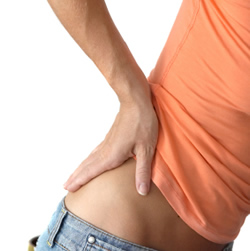History and Presenting Symptoms

A 56-year-old male presents with recurring episodes of moderate pain and “tension” in his left hip. He denies injuring the hip, and cannot discern any specific precipitating activities or events. Mornings seem to be particularly problematic, but the pain is never disabling. On a 100mm Visual Analog Scale, he rates his left hip pain around 45mm. He takes over-the-counter NSAID’s, which provide sufficient relief. However, he desires to discontinue taking drugs for his hip pain.
Exam Findings
Vitals. This active male weighs 175 lbs., which, at 5’10’’, results in a BMI of 25—right on the borderline of overweight. He works out regularly on resistance machines at his local community recreation center, which indicates that some of his excess weight is possibly lean body mass. He doesn’t smoke, his blood pressure is 118/78mmHg, and his pulse rate is 76 bpm. These findings are within the normal range.
Posture and gait. Standing postural evaluation finds a lower iliac crest on the right and a low right greater trochanter. The left shoulder is somewhat lower than the right, with no history of fracture or surgery. His knees are well aligned, but there is obvious medial bowing of the right Achilles tendon, with a lower medial arch on the right foot.
Chiropractic evaluation. Motion palpation identifies several mild limitations in spinal motion: the left SI joint, the lumbosacral junction, T11/12, and at the cervicothoracic junction. Palpation finds no significant tenderness in these regions, and all active spinal ranges of motion are pain free. Hip ranges of motion are also pain-free. Provocative orthopedic and neurological tests for nerve root impingement and/or disc involvement are negative.
Lower extremities. Closer examination finds that the right medial foot arch is lower than the left when standing. His right calcaneus is everted when bearing weight. When he is seated and non-weightbearing, the right arch appears equal to the left, and when he performs a toe-raise while standing, the right arch returns. Manual testing finds no evidence of weakness in the peroneal or anterior tibial muscles.
:dropcap_open:Chronic hip pain must be evaluated fully, in order to identify any underlying problems and propose effective treatment.:quoteleft_close:
Imaging
A-P and lateral lumbopelvic X-rays are taken in the upright, weightbearing position. A discrepancy in femur head heights is noted, with a measured difference of 6 mm (right side lower). A moderate lumbar curvature (8°) is noted, convex to the right side, and both the sacral base and iliac crest are lower on the right. The sacral base angle and measured lumbar lordosis are increased, but not outside of normal limits. No loss of joint spacing or osteophyte formation is identified in the hip joints.
Clinical Impression
Moderate functional leg length discrepancy (right short leg), with associated pelvic tilt and slight lumbar curvature. There is an accompanying history of chronic left hip pain.
Treatment Plan
Adjustments. Specific, corrective adjustments for the SI joints and the lumbar, thoracic, and cervical regions were provided as needed, with goodresponse. Right-foot manipulation, including navicular, cuboid, and calcaneal bones, was also performed.
Support. Custom-made, flexible stabilizing orthotics were provided, with added pronation correction on the right side. The adaptation process posed no difficulties.
Rehabilitation. He was shown a series of standing hip strengthening exercises in all ranges, using elastic resistance tubing. His exercise log was reviewed at each visit to ensure adherence to the exercises.
Response to Care
All adjustments were well tolerated, and orthotics helped to improve his postural alignment. After four weeks of adjustments (eight visits), daily home exercises, and wearing the orthotics, he successfully completed his re-examination and was released to a self-directed maintenance program.
Discussion
With no history of leg, hip or pelvic injury, this patient apparently had a functional right short leg that produced a chronic biomechanical stress on the left hip joint. Pronation and biomechanical asymmetry in the foot and ankle are seldom locally symptomatic. Chronic hip pain must be evaluated fully, in order to identify any underlying problems, rule out osteoarthritis and other important conditions, and propose effective treatment. The foot and spinal adjustments and the hip exercises were helpful, but the problem most in need of correction was the pronation asymmetry that caused a functional imbalance at the hips and pelvis.
